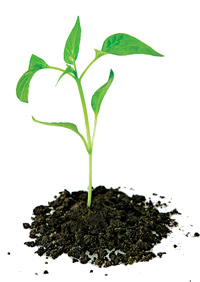Agriculture: An Atmosphere of Uncertainty
By Jillian Randel
Among growing concerns about the warming of the earth and the buildup of greenhouse gases is the impact that climate change has on our food supply.
Irregular precipitation patterns, rising temperatures and higher levels of carbon dioxide could govern how and what food is grown and sold in Appalachia and worldwide in the coming years.
The only reliable factor in this equation is the level of uncertainty that surrounds climate change and its impact on agriculture — an already volatile science based on hard-to-predict weather patterns.
Uncertainty is the theme as atmosphere changes develop, followed by predictions on how these changes will affect our food chain as we move forward.
When it Rains, it Pours
Erratic behavior is the name of the game when it comes to precipitation patterns in the coming years. Scientists at the University of Maryland’s Center for Integrative Environmental Research predict a mix of longer, intense droughts with increased rainfall in the form of high volume storms and flooding.
“Dry weather can scare you to death, but wet weather can starve you to death,” said Charles Church, owner of Watauga River Farms in Valle Crucis, N.C. “You worry a lot when there’s a drought cause you’re afraid your plants are not going to get watered enough, but too much water can totally ruin them.”
According to the Intergovernmental Panel on Climate Change, frequent flooding can generate low levels of oxygen in the soil, increase crop susceptibility to root diseases, cause severe erosion and increase runoff and leaching of agricultural chemicals into surface water.
“About a year ago we had a big rainfall on one corner of the [school’s] farm,” said Christof den Biggelaar, associate professor of Agroecology and Sustainable Development at Appalachian State University in Boone, N.C. “In that corner, all the onions and garlic roots were exposed because the rain had washed the soil away.”
Drought has also been a problem in Appalachia.
“For the most part rainfall here is pretty generous. You could count on about an inch a week, but the last few years it’s been difficult to plan on that,” said den Biggelaar. “With farming you look at longer term trends and it seems like over the last few years you have all these stats you almost have to throw out the door.”
It’s Getting Hot Out There
According to the U.S. Global Change Research Program, the annual average temperature in the Southeast has risen about 2˚F since 1970. Temperatures in the Southeast are projected to rise about 4.5˚F by the 2080s under a lower emission scenario, and under a higher emission scenario are expected to rise about 9˚F by that time.
Higher temperatures benefit crops that grow well in the heat, but will negatively impact crops that prefer cooler growing seasons. Appalachia’s cool mountain growing climate provides the region with a distinct market edge.
“It is good for farmers here when they can grow cold weather crops during summer months and places like California and Florida can’t,” said den Biggelaar. “Broccoli prices go up and farmers can be competitive and still pay bills.”
With temperatures on the rise, plants demand more water to survive. Without adequate water for cooling, plants suffer heat stress.
“The problem is with unpredictability,” said den Biggelaar. “There are lot more small farms here that don’t have irrigation, but you never needed it because rainfall was regular and it never got really hot. Now that is changing.”
According to den Biggelaar, the Appalachian State Teaching and Research Farm has had trouble growing many Appalachian summer crops such as broccoli, spinach, cabbage and lettuce, making it hard to keep up with demand from their Community Supported Agriculture program.
Shorter and warmer winters will also negatively impact agriculture, according to the U.S. Global Change Research Program, with warmer temperatures affecting fruits that require more nights below a certain temperature. Many apples and berries require between 400 and 1,800 cumulative hours below 45˚F to produce abundant yields.
“If spring gets warm earlier the trees might bud and then frost early and you lose your crop,” said den Biggelaar. “In 2007 there was a late Easter freeze and there were no apples and very few blueberries; we lost a lot.”
Carbon Dioxide: A Fair-Weathered Friend
One of the most widely recognized effects of climate change is increased levels of carbon dioxide (CO2). Increased levels of CO2 act as a fertilizer for many plants. In many greenhouses, farmers are finding ways to increase these levels to stimulate faster plant growth.
“Carbon dioxide is a double-edged sword,” said den Biggelaar. “For direct crop production it would be good, but higher CO2 in the air increases acidity of oceans and air, which is a bad thing.”
Weeds and Pests: According to the U.S. Global Change Research program, as temperatures increase, certain species of pests and weeds begin to move northward and spread. Warmer winters no longer provide the severe cold needed to kill off many insects and pests.
Rising Temps Make the Cows Come Home
Increased temperatures and humidity puts greater strain on livestock, which in turn reduces their ability to produce milk, gain weight or reproduce.
Animals suffer heat stress from longer and hotter summers. Just like plants, they require cooler nights to recover from heat. This recovery time will be harder to find with temperatures rising.
Studies done for the University of Maryland’s Center for Integrative Environmental Research show that a 9˚F increase in temperature reduces livestock yield in animal and dairy operations by about 10 percent in the Appalachian region.
Variations in climate can also affect the forage that many animals rely on for their diet.
Weather: A Lost Ball in the High Weeds
Agriculture is a science based on predictions and patterns that will never be exact.
“I have farmed my whole life and I’ve seen periods where it is extra hot and extra dry,” said Church, who doesn’t necessarily believe in climate change. “It’s something that has gone on since the beginning of time. I see year by year it can be hotter and dryer, then right back to wet the next year.”
Weather patterns are becoming harder to predict, but the question we must address is: what can we do now to ensure a secure future for our food systems?
More Stories

Leave a comment
Your email address will not be published. Required fields are marked *
One response to “Agriculture: An Atmosphere of Uncertainty”
-
Has anyone questioned how ongoing weather modification & climate engineering is affecting our agriculture, much less the loss of trees, etc? I have been witnessing relentless climate engineering in NWNC since March 2014, but it is known that experimentation has been ongoing across the nation & in NATO countries for decades now. http://www.GeoengineeringChemwatch.com








Leave a Comment